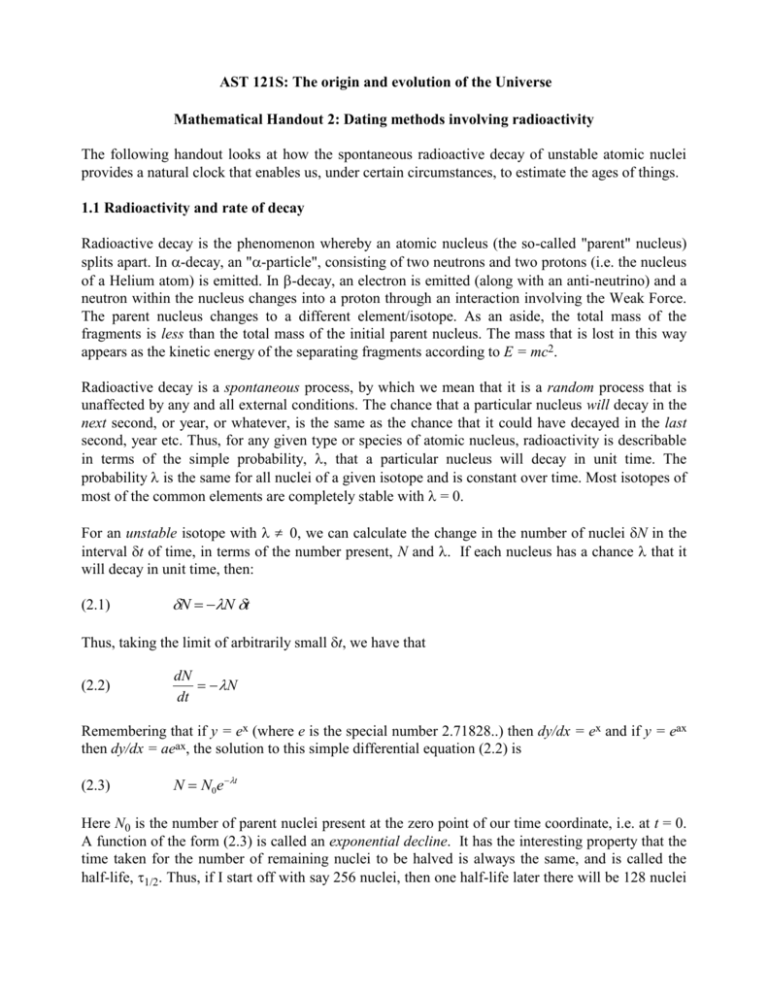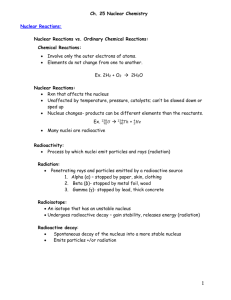AST 121S: The origin and evolution of the Universe
advertisement

AST 121S: The origin and evolution of the Universe Mathematical Handout 2: Dating methods involving radioactivity The following handout looks at how the spontaneous radioactive decay of unstable atomic nuclei provides a natural clock that enables us, under certain circumstances, to estimate the ages of things. 1.1 Radioactivity and rate of decay Radioactive decay is the phenomenon whereby an atomic nucleus (the so-called "parent" nucleus) splits apart. In -decay, an "-particle", consisting of two neutrons and two protons (i.e. the nucleus of a Helium atom) is emitted. In -decay, an electron is emitted (along with an anti-neutrino) and a neutron within the nucleus changes into a proton through an interaction involving the Weak Force. The parent nucleus changes to a different element/isotope. As an aside, the total mass of the fragments is less than the total mass of the initial parent nucleus. The mass that is lost in this way appears as the kinetic energy of the separating fragments according to E = mc2. Radioactive decay is a spontaneous process, by which we mean that it is a random process that is unaffected by any and all external conditions. The chance that a particular nucleus will decay in the next second, or year, or whatever, is the same as the chance that it could have decayed in the last second, year etc. Thus, for any given type or species of atomic nucleus, radioactivity is describable in terms of the simple probability, that a particular nucleus will decay in unit time. The probability is the same for all nuclei of a given isotope and is constant over time. Most isotopes of most of the common elements are completely stable with = 0. For an unstable isotope with 0, we can calculate the change in the number of nuclei N in the interval t of time, in terms of the number present, N and . If each nucleus has a chance that it will decay in unit time, then: (2.1) N N t Thus, taking the limit of arbitrarily small t, we have that (2.2) dN N dt Remembering that if y = ex (where e is the special number 2.71828..) then dy/dx = ex and if y = eax then dy/dx = aeax, the solution to this simple differential equation (2.2) is (2.3) N N0e t Here N0 is the number of parent nuclei present at the zero point of our time coordinate, i.e. at t = 0. A function of the form (2.3) is called an exponential decline. It has the interesting property that the time taken for the number of remaining nuclei to be halved is always the same, and is called the half-life, 1/2. Thus, if I start off with say 256 nuclei, then one half-life later there will be 128 nuclei left, after another half-life there will be 64, after another half-life there will be 32, then 16, then 8 and so on. The half-life 1/2 is related to the decay rate by (2.4) 1/ 2 0. 693 Because the decay of radioactive nuclei is a random process that does not depend on any external influences, radioactive decay provides a clock by which objects can be dated. Two instances of this are especially interesting and easily understandable. 2. Radioactive Carbon-14 dating Carbon comes in two isotopes, 12C which is stable, and the much rarer Radioactive 14C decays to 14N through a -decay with a half-life of 5370 years. 14C which is not. The isotopes of Carbon are interesting because the radioactive isotope, 14C, is continually made in the upper atmosphere (as an aside, by interactions with energetic cosmic rays from space) and the ratio of 14C/12C in the atmosphere is maintained at a constant value of about 1.5x10-12. This equilibrium level is such that the rate of production of new 14C by the cosmic rays is exactly balanced by the radioactive decay of existing 14C). Furthermore, all living things (both plants and animals) are continually exchanging carbon with the atmosphere, through the emission and absorption of carbon dioxide (CO2). This means that the 14C/12C ratio in all living things is maintained at this same level of 1.5x10-12. Once death occurs however, this exchange stops. The 14C in the body that is present at death decays and is not replenished by newly produced 14C (since the production of 14C occurs only in the upper atmosphere and respiration has ceased on death). Thus the ratio of 14C/12C declines as the 14C decays. (2.5) N 14C 1.5 1012 e t N 12C where t measures the time since death. Thus, measurement of the 14C/12C ratio in some once living object tells us how long that object has been dead. This method can be applied to material like linen which is made from plant material. Note that the half-life of 14C (about 5000 years) is quite well-matched to the dating of human artifacts. Over "historical" intervals of 1000-10000 years the 14C has decayed significantly but not so much as to be undetectable. 3. The ages of rocks The success of radioactive 14C dating depends on the peculiar feature of living things to exchange CO2 with the atmosphere and on the fact that 14C is continuously produced in the upper atmosphere. Carbon-14 dating is of little use for cosmological purposes. However, a different analysis, again based on a particular set of conditions, can be applied to date the time since solidification of rocks. This can be used to estimate the age of the Earth (or at least a minimum age of the Earth). The estimate of the Earth's age obtained in this way is still one of the main constraints on the age of the Universe. Suppose we have some element whose isotope iD is the product of a radioactive decay of some radioactive kP, and that the decay rate of this decay is We will assume that iD is itself stable to radioactive decay. Note that here I am using iD and kP to represent any pair of elements/isotopes that are of interest. In any part of the rock, the number of iD atoms present at any time, which we will write as N(iD), is the sum of any initial abundance of iD, N0(iD) and the abundance of the radioactively produced iD produced through the decay of the parent isotope, kP, Nr(iD). (2.6) N i D N0 i D Nr i D Note that, because I have assumed that iD is itself stable, no radioactive decay of iD occurs. Now the number of radioactively produced iD atoms, Nr(iD), is the same as the number of kP that have decayed, which itself is the number that were initially present, , minus the number that are still present at some later time, . (2.7) Nr i D N0 k P N k P N(kP) is, from (2.3), e-t times the initial number N0(kP) (2.8) N k P N 0 ( k P)e -t N 0 k P N ( k P)e t Thus we can rewrite (2.6) in terms of the measurable numbers of iD and kP atoms, the known decay rate , the unknown age t and the unknown initial number of iD, N0(iD). (2.9) N i D N 0 i D N k P e t 1 Ideally, we try to normalize the abundance of iD to some other stable isotope of the element D that is neither produced nor decayed through radioactivity, so that N(jD) is constant over time (and thus measurable at any time). If we call this isotope jD, then (3.0) N (iD) N 0 (iD) N ( k P) t e 1 N ( j D) N ( j D) N ( j D) Different parts of a typical rock will have started off with different (P/D)0 ratios (such chemical variations from place to place in a rock are eminently reasonable) but the same (iD/jD)0 ratio (the lack of isotopic variations is also reasonable, since chemical effects are blind to the different isotopes - the differences between isotopes are confined to the nuclei of atoms) then we can plot the measured N(iD)/N(jD) against N(kP)/N(jD) at some epoch t. This graph will be a straight line of slope (et-1). If we know for the radioactive decay by which kP decays to iD (we can measure this in a laboratory), we can obtain t from the slope of the graph. The intercept of the graph gives the initial ratio of iD to jD (which is not itself of great interest). Note that the accuracy of the age determinations using this method will depend on the degree of variation in the initial P/D ratio through the rock - i.e. completely homogeneous rock which had exactly the same chemical composition everywhere can not be dated by this method. The age t is clearly the time since solidification of the rock, since it is only after solidification that the products of radioactive decay stay in the same location that they were produced (atoms are free to move around a liquid or a gas). The method relies on local abundance measurements in which the products of radioactive decay are assumed to stay in situ. In practice, some of the most useful pairs of iD and kP are as follows, with their associated halflives: 87Rb 87Sr 232Th 208Pb 238U 206Pb 235U 207Pb 147Sm 143Nd 4.99 x 1010yrs 1.39 x 1010 yrs 4.50 x 109 yrs 7.13 x 108 yrs 10.6 x 1010 yrs The oldest rocks on Earth are about 4.2 billion years old, as estimated from this method. The oldest rocks from the Moon are 4.5 billion years old - the difference being accounted for in the more complex geology of Earth which continually reprocesses surface rocks. The age of the Solar System is taken to be 4.6 0.1 billion years. This provides an estimate of the age of the Sun (since the Sun and the Solar System almost certainly formed at the same time) and also a firm lower limit to the age of the Universe. 4. The age of the elements In Section 2, the use of Carbon-14 age estimates for things that were once alive relied on some special features of 14C. Similarly, the analysis in Section 3 only works once the material in question is in solid form, and yields an age since solidification. Is it possible to derive an estimate of the time that has elapsed since the elements were initially created? From the foregoing sections it should be clear that if (a) all the kP and iD in the Universe had been created at one particular time, (b) we knew the initial iD/kP ratio produced at this time and (c) we could assume that the ratio of iD to kP that we measured in some location at the present time was the same as found elsewhere, then a measurement of this ratio would tell us how long had elapsed since the elements in question had been produced. None of these three assumptions are true in detail, but more or less complicated analyses can take in to account the difficulties implied by the fact that (a) (c) are not entirely valid. These analyses, which we won't be discussing, suggest that the elements have been produced in the Milky Way Galaxy over a period that started some 10-20 billion years ago, entirely consistent with the estimate of the age of the Sun and Solar System.








